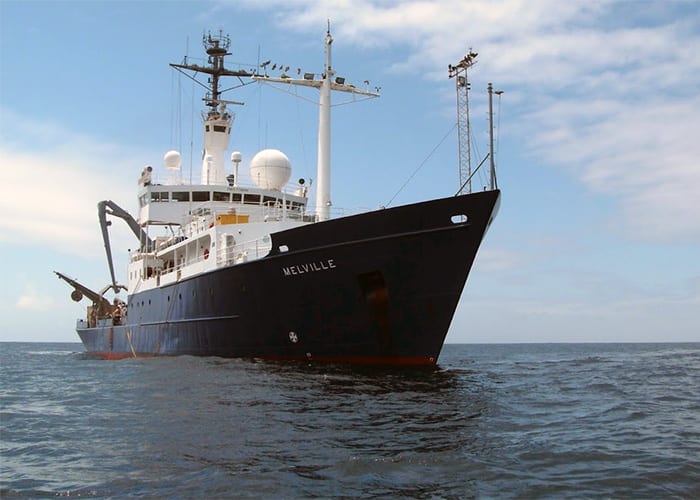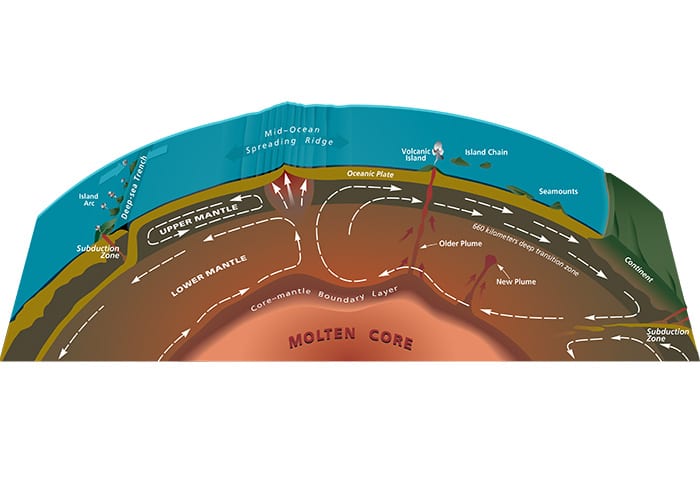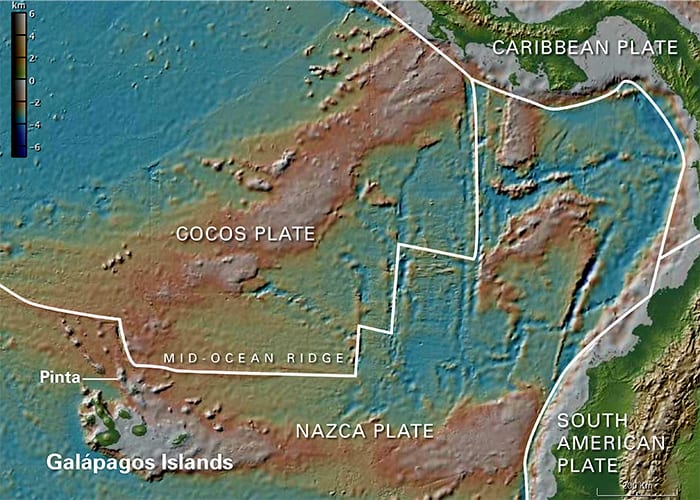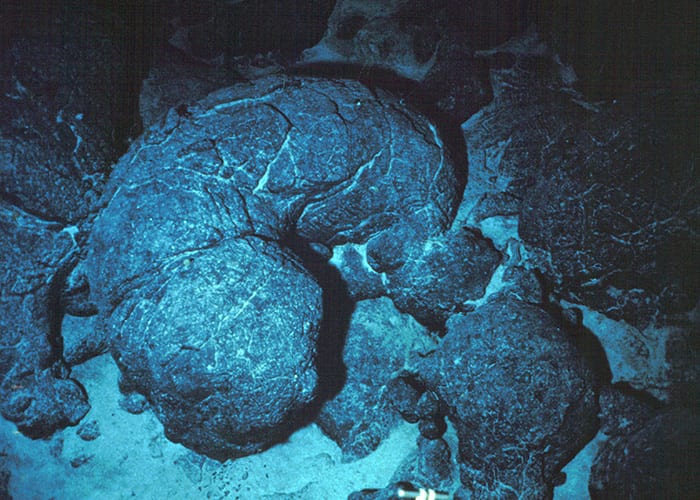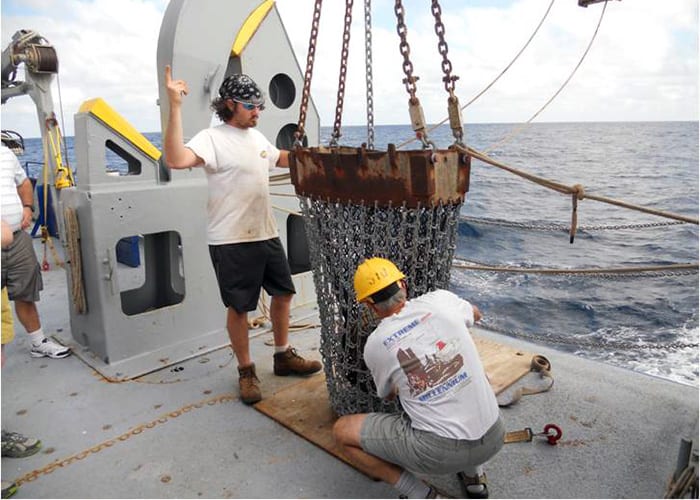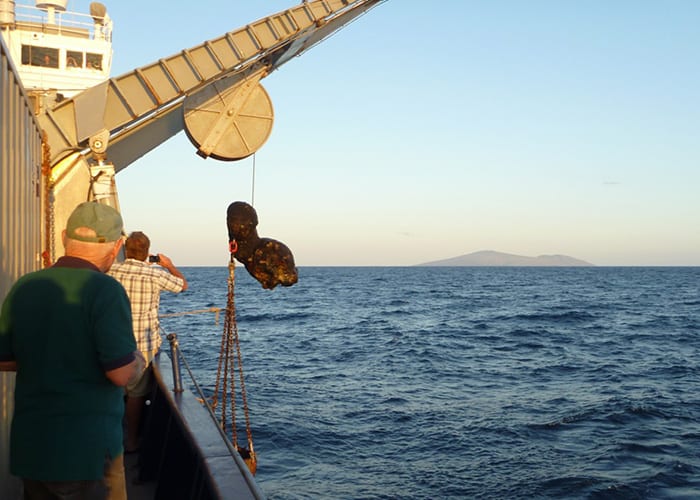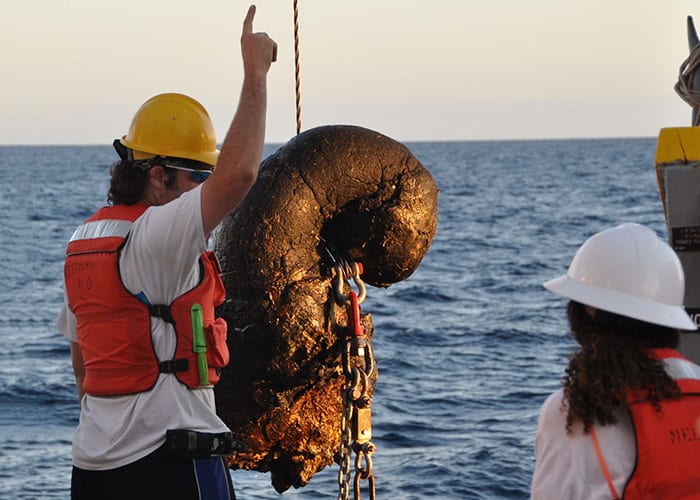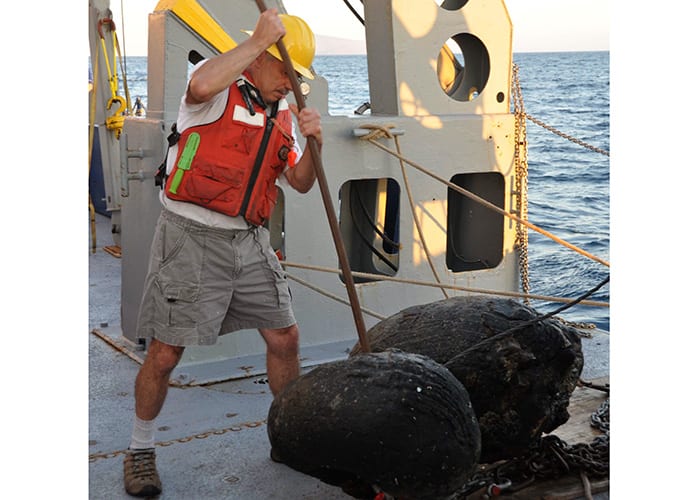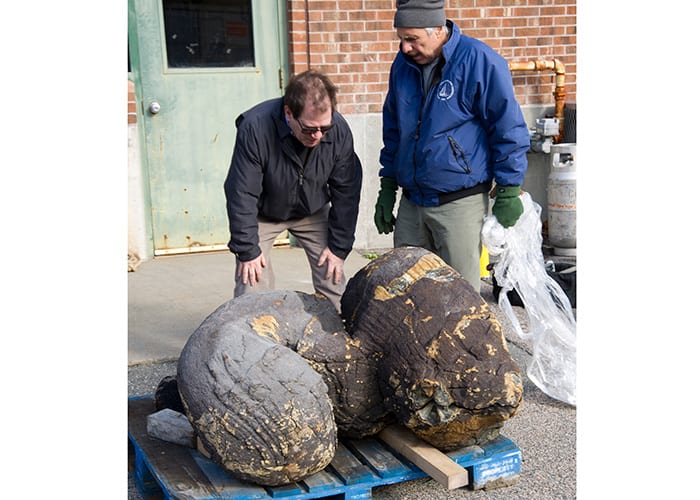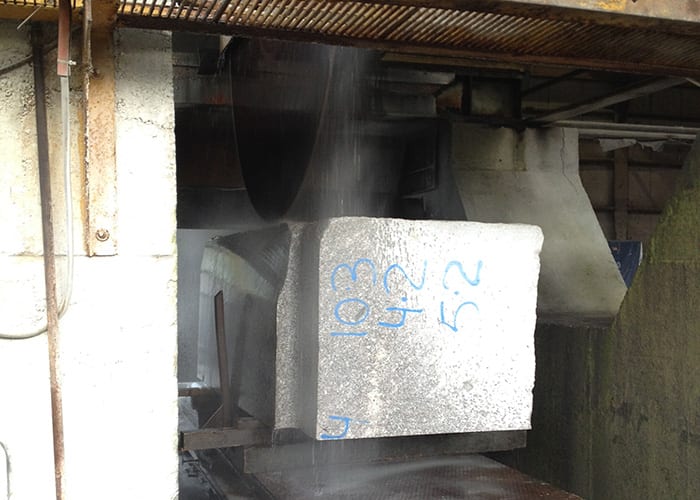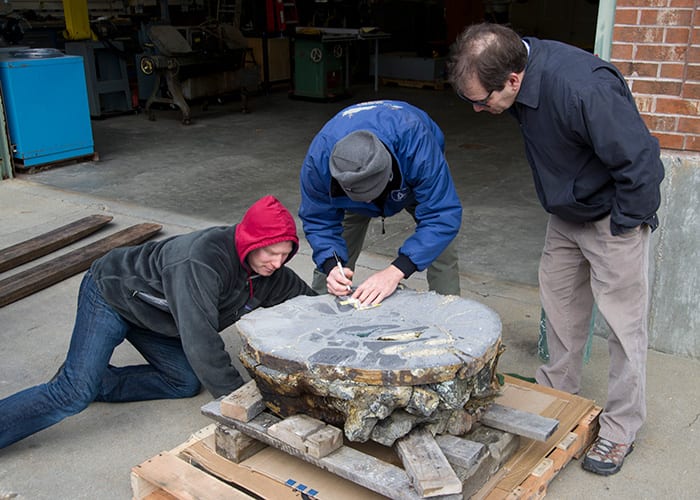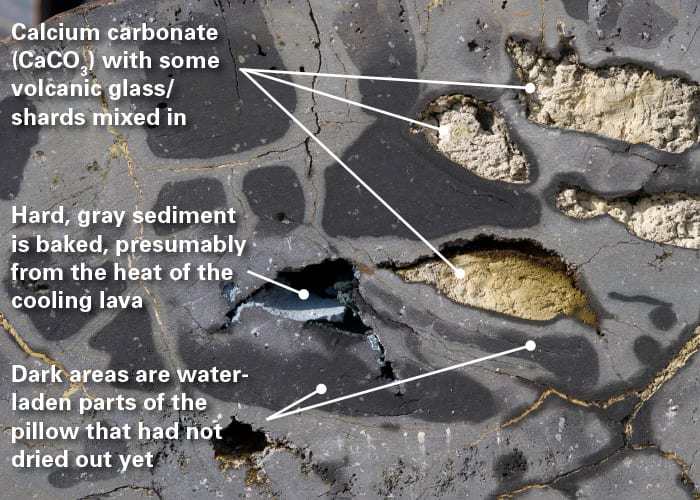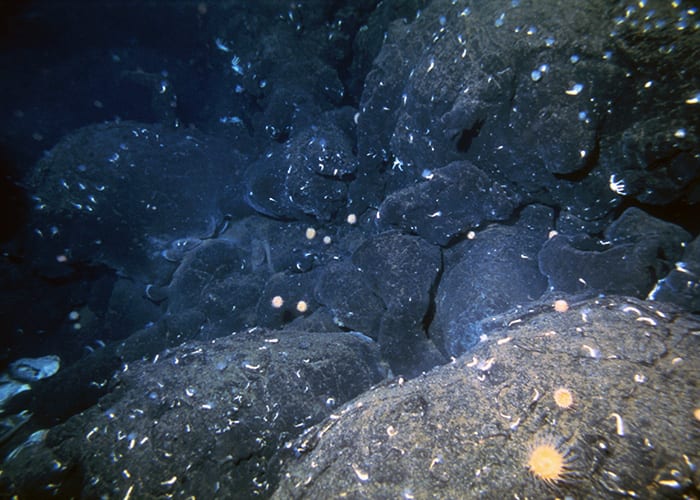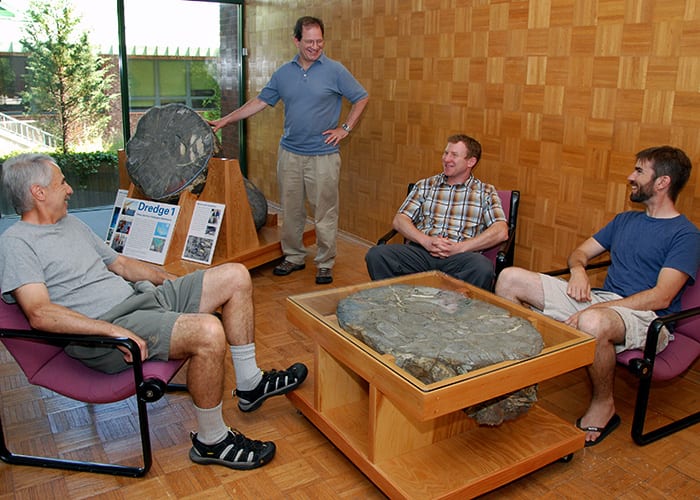- Not far off Pinta, an island in the Galápagos archipelago, a team of scientists aboard the research vessel Melville cast a cable into the deep, hoping to bring back samples of volcanic rocks from the seafloor. They hooked a big one—and it didn’t get away.
- The Galápagos, like Hawaii, lie atop a hotspot—a place on Earth’s face where a narrow plume of partially molten rock from deep in Earth’s hot interior rises and bursts through the crust in seafloor volcanoes. If the volcanic eruptions are frequent and voluminous, lava piles high enough to form undersea mountains, or seamounts. If the volcanoes are active for long enough, seamounts can reach beyond the ocean surface to create islands.
- The Galápagos region off the west coast of South America is especially interesting and complicated because it lies near the boundaries of two of Earth’s tectonic plates. As the plates spread apart, magma rises in between, creating a volcanic mountainous mid-ocean ridge. Aboard the <em>Melville</em> in 2010, chief scientist Karen Harpp from Colgate University led a team of scientists from several institutions, including Dennis Geist from U. of Idaho and Eric Mittelstaedt, Dan Fornari, Adam Soule, and Mark Kurz from WHOI. They explored questions such as: What is happening in Earth’s interior to feed volcanic eruptions on mid-ocean ridges and on hotspot islands such the Galápagos, Hawaii, and Iceland? How do seafloor lava flows eventually build islands?
- Magma erupting at the seafloor often forms “pillow” lava. It forms when the molten rock, at temperatures of 2,200°F or 1,200°C, hits 35°F (2°C) seawater. “Within a fraction of a second, a glassy skin forms on the lava surface, encapsulating a blob of lava,” said Adam Soule, a volcanologist at Woods Hole Oceanographic Institution (WHOI). “Continued injection of lava causes the pillow to stretch and expand, like a water balloon. New pillows form when hot lava bursts through the chilled skin of a previous pillow.”
- Lava from plumes and from mid-ocean ridges have different characteristics, so to learn more about these two fundamental magmatic sources, the scientists sought samples of volcanic rock to analyze. They lowered a chain-metal basket called a dredge via a steel cable to the seafloor to collect the samples.
- During a dredging operation on May 31, 2010, the tension on the cable more than doubled to 2,200 pounds, indicating that the dredge had caught something big. When the dredge reached the surface, scientists and crew were astounded to see that the dredge hadn’t captured the prize. Instead, the cable near the top of the dredge snagged the nook between two bulbous pillows and wrenched it up from the seafloor.
- Melville crew members carefully maneuvered the massive seafloor lava onto the deck.
- The pillow lava weighed nearly 800 pounds. “It is among the largest lava samples ever collected from the seafloor,” said Dan Fornari (above), a marine geologist at WHOI who has long studied volcanic processes that create and shape the seafloor.
- Fornari arranged to send the sample back to WHOI, where he and other scientists, including geochemist Mark Kurz (left) could analyze it further. Kurz has long studied gases trapped in seafloor rocks to learn about processes occurring in Earth’s interior that lead to seafloor volcanism.
- The scientists wanted to look inside the pillow lava, so they brought it to a rock quarry in Rhode Island equipped with mammoth saws that usually cut large slabs of granite.
- When WHOI scientists (l to r) Adam Soule, Dan Fornari, and Mark Kurz examined the inside of the cut-open pillow lava, they found something that had never been observed before. Embedded within the lava were pockets of sediments from the seafloor.
- The scientists surmised that as the lava was squeezed out over the seafloor like toothpaste coming out of a tube, the sediments were captured and incorporated into it. Some of sediment was baked, presumably by the lava; other areas contain less consolidated sediment. The sediment is made of calcium carbonate (CaCO3) from the shells of tiny organisms that are at the low end of the food chain in the oceans.
- It is notoriously difficult to discern how old lava is, Fornari said, but shells of organisms preserved in the sediments can be radiocarbon-dated. WHOI postdoctoral scientist Andrea Hawkes extracted a preserved shell that was 40,000 years old, indicating that the seafloor eruption that created the lava occurred at least that long ago.
- Some of the serendipitously snagged lava now rests in the foyer of the Clark Laboratory at WHOI. Part was used in a display telling the tale of its discovery, and part was used to make a table, where scientists and visitors can rest their coffee mugs and feet on something that came from deep within the Earth and from the bottom of the ocean. (From left, WHOI Scientists Dan Fornari, Mark Kurz, Adam Soule, and Eric Mittelstaedt.)
SEARCH RELATED TOPICS: Mid-ocean Ridges
Image and Visual Licensing
WHOI copyright digital assets (stills and video) contained on this website can be licensed for non-commercial use upon request and approval. Please contact WHOI Digital Assets at images@whoi.edu or (508) 289-2647.
